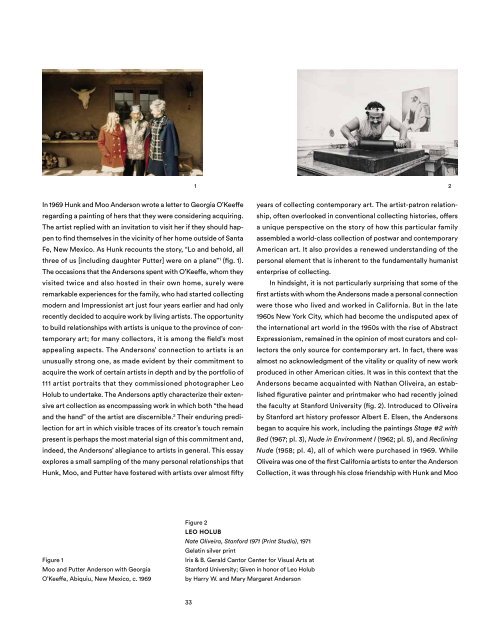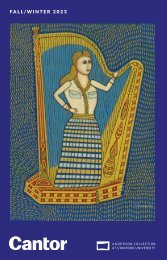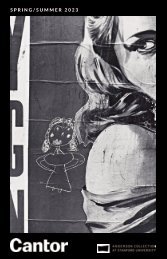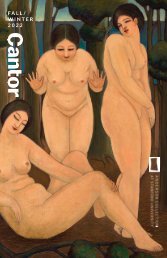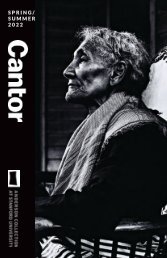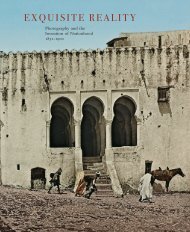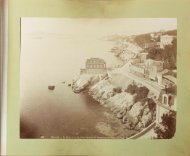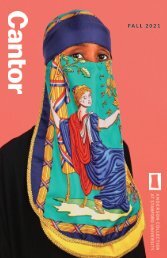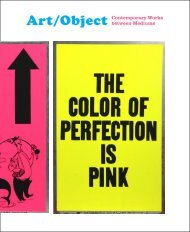A Family Affair
Essays on Modern and Contemporary Art from the Anderson Collection at Stanford University
Essays on Modern and Contemporary Art from the Anderson Collection at Stanford University
You also want an ePaper? Increase the reach of your titles
YUMPU automatically turns print PDFs into web optimized ePapers that Google loves.
1 2<br />
In 1969 Hunk and Moo Anderson wrote a letter to Georgia O’Keeffe<br />
regarding a painting of hers that they were considering acquiring.<br />
The artist replied with an invitation to visit her if they should happen<br />
to find themselves in the vicinity of her home outside of Santa<br />
Fe, New Mexico. As Hunk recounts the story, “Lo and behold, all<br />
three of us [including daughter Putter] were on a plane” 1 (fig. 1).<br />
The occasions that the Andersons spent with O’Keeffe, whom they<br />
visited twice and also hosted in their own home, surely were<br />
remarkable experiences for the family, who had started collecting<br />
modern and Impressionist art just four years earlier and had only<br />
recently decided to acquire work by living artists. The opportunity<br />
to build relationships with artists is unique to the province of contemporary<br />
art; for many collectors, it is among the field’s most<br />
appealing aspects. The Andersons’ connection to artists is an<br />
unusually strong one, as made evident by their commitment to<br />
acquire the work of certain artists in depth and by the portfolio of<br />
111 artist portraits that they commissioned photographer Leo<br />
Holub to undertake. The Andersons aptly characterize their extensive<br />
art collection as encompassing work in which both “the head<br />
and the hand” of the artist are discernible. 2 Their enduring predilection<br />
for art in which visible traces of its creator’s touch remain<br />
present is perhaps the most material sign of this commitment and,<br />
indeed, the Andersons’ allegiance to artists in general. This essay<br />
explores a small sampling of the many personal relationships that<br />
Hunk, Moo, and Putter have fostered with artists over almost fifty<br />
years of collecting contemporary art. The artist-patron relationship,<br />
often overlooked in conventional collecting histories, offers<br />
a unique perspective on the story of how this particular family<br />
assembled a world-class collection of postwar and contemporary<br />
American art. It also provides a renewed understanding of the<br />
personal element that is inherent to the fundamentally humanist<br />
enterprise of collecting.<br />
In hindsight, it is not particularly surprising that some of the<br />
first artists with whom the Andersons made a personal connection<br />
were those who lived and worked in California. But in the late<br />
1960s New York City, which had become the undisputed apex of<br />
the international art world in the 1950s with the rise of Abstract<br />
Expressionism, remained in the opinion of most curators and collectors<br />
the only source for contemporary art. In fact, there was<br />
almost no acknowledgment of the vitality or quality of new work<br />
produced in other American cities. It was in this context that the<br />
Andersons became acquainted with Nathan Oliveira, an established<br />
figurative painter and printmaker who had recently joined<br />
the faculty at Stanford University (fig. 2). Introduced to Oliveira<br />
by Stanford art history professor Albert E. Elsen, the Andersons<br />
began to acquire his work, including the paintings Stage #2 with<br />
Bed (1967; pl. 3), Nude in Environment I (1962; pl. 5), and Reclining<br />
Nude (1958; pl. 4), all of which were purchased in 1969. While<br />
Oliveira was one of the first California artists to enter the Anderson<br />
Collection, it was through his close friendship with Hunk and Moo<br />
Figure 1<br />
Moo and Putter Anderson with Georgia<br />
O’Keeffe, Abiquiu, New Mexico, c. 1969<br />
Figure 2<br />
LEO HOLUB<br />
Nate Oliveira, Stanford 1971 (Print Studio), 1971<br />
Gelatin silver print<br />
Iris & B. Gerald Cantor Center for Visual Arts at<br />
Stanford University; Given in honor of Leo Holub<br />
by Harry W. and Mary Margaret Anderson<br />
33


